|

by William K. Hartmann
A Project in Astronomical Art,
Science, and History (In Progress)
Text and pictures William K. Hartmann
from
PlanetaryScienceInstitute Website
|
In Brief
At 7:17 AM on the morning of June 30, 1908, a mysterious
explosion occurred in the skies over Siberia. It was
caused by the impact and breakup of a large meteorite,
at an altitude roughly six kilometers in the atmosphere.
Realistic pictures of the event are unavailable.
However, Russian scientists collected eyewitness
accounts of the event. I believe that we now know enough
about large impacts to "decode" the subjective
descriptions of the witnesses and create realistic views
of this historic asteroid impact as seen from different
distances. |
What do we
know about the explosion?
You can get a sense of the magnitude of this event by comparing
observations made at different distances. Seismic
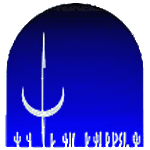 vibrations
were recorded by sensitive instruments as much as 1000 km (600 mi)
away. vibrations
were recorded by sensitive instruments as much as 1000 km (600 mi)
away.
At 500 km (300 mi), observers reported "deafening bangs" and a
fiery cloud on the horizon.
About 170 km (110 mi) from the
explosion, the object was seen in the cloudless, daytime sky as a
brilliant, sun-like fireball; thunderous noises were heard.
At
distances around 60 km, people were thrown to the ground or even
knocked unconscious; windows were broken and crockery knocked off
shelves. Probably the closest observers were some reindeer herders
asleep in their tents in several camps about 30 km (20 mi) from the
site.
They were blown into the air and knocked
unconscious; one man was blown into a tree and later died.
"Everything around was shrouded in smoke and fog from the burning
fallen trees."
My Paintings
of the Event
A few years ago, I decided to use eyewitness reports such as the
following ones, collected by Russian scientists decades ago, to
reconstruct the appearance of the event from various locations, and
at various moments.
Here are descriptions of my work so far.
400 KM Southeast of Ground Zero
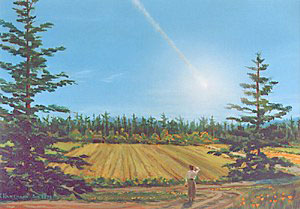
View from Kirensk,
two seconds before the explosion.
Painting © William K. Hartmann
Witnesses in the town of Kirensk and
nearby towns at the same distance recollected the fireball
flashing across the sky in the following terms:
"A ball of fire...coming down
obliquely. A few minutes later [we heard] separate deafening
crash like peals of thunder... followed by eight loud bangs
like gunshots."
"A ball of fire appeared in the sky... As it approached the
ground, it took on a flattened shape..."
"A flying star with a fiery tail; its tail disappeared into
the air."
After this object passed across the
sky, it approached the horizon where it was consistently
described from this distance of 400 km, as appearing like a
"pillar of fire," then replaced by "a cloud of smoke rising from
the ground," or "a cloud of ash...on the horizon," or "a huge
cloud of black smoke.
"From a closer distance of around 200 km,
several witnesses gave a better description of the object
itself. It was called diffuse bright ball two or three times
larger than the sun but not as bright; the trail was a
"fiery-white band."
Inconsistent colors were mentioned: white,
red, flame-like, bluish-white.
Perhaps it had a flame-like
iridescence. I used these descriptions in this painting, but I
compensated for the twice-greater distance.
I used a visit to
Washington state as an opportunity to find a landscape that
generally matched the photos from Siberia, and then I painted
this piney-woodland scene from life, adding the fireball from
the above descriptions.
60 KM South of Ground Zero
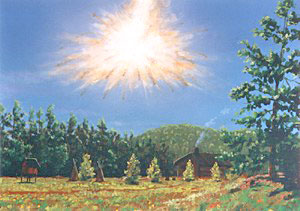
View from
Vanavara trading post, at the moment of the explosion.
Painting © William K. Hartmann
The Russians collected a number of
accounts from eyewitnesses at the trading station, which was
probably the closest permanent habitation. These included:
"I was sitting on the porch of
the house at the trading station, looking north.
Suddenly in
the north...the sky was split in two, and high above the
forest the whole northern part of the sky appeared covered
with fire. I felt a great heat, as if my shirt had caught
fire... At that moment there was a bang in the sky, and a
mighty crash...
I was thrown twenty feet from the porch and
lost consciousness for a moment... The crash was followed
by a noise like stones falling from the sky, or guns firing.
The earth trembled... At the moment when the sky opened, a
hot wind, as if from a cannon, blew past the huts from the
north. It damaged the onion plants. Later, we found that
many panes in the windows had been blown out and the iron
hasp in the barn door had been broken."
A second witness said:
"I saw the sky in the north open
to the ground and fire poured out. The fire was brighter
than the sun. We were terrified, but the sky closed again
and immediately afterward, bangs like gunshots were heard.
We thought stones were falling... I ran with my head down
and covered, because I was afraid stones may fall on it."
In this painting I tried to show the
moment when "the sky opened and with fire."
I used the more
distant reports, of the fire ball spreading and flattening at
the end of its trajectory, to give the shape of fiery trail and
the explosive fireball.
I painted the basic landscape from life
in a Siberian-looking landscape outside of Flagstaff Arizona,
basing the structures on old photos from the expeditions to the
Siberian impact area.
15 KM from Ground Zero
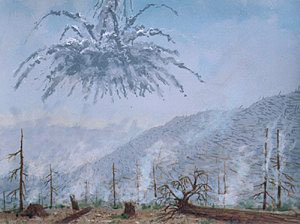
A few minutes
after the explosion
Painting © William K. Hartmann
Because the object exploded up in
the atmosphere, instead of hitting the ground, it left no
crater.
The effect on the ground was limited to devastation of a
large forest area. At ground zero, tree branches were stripped,
leaving trunks standing up. But at distances from roughly 3 out
to 10 miles, the trees were blown over, lying with tops pointed
away from the blast. No one was known to have been this close to
the blast.
The closest humans were probably herders camped in
tents roughly 30 km from ground zero. They related:
"Early in the morning when
everyone was asleep in the tent, it was blown up in the air
along with its occupants. Some lost consciousness. When they
regained consciousness, they heard a great deal of noise and
saw the forest burning around them, much of it devastated."
"The ground shook and incredibly prolonged roaring was
heard. Everything round about was shrouded in smoke and fog
from burning, falling trees. Eventually the noise died away
and the wind dropped, but the forest went on burning. Many
reindeer rushed away and were lost."
One older man at about this distance
was reportedly blown about forty feet into a tree, causing a
compound fracture of his arm, and he soon died.
Hundreds of the
herders' reindeer, in the general area around ground zero, were
killed. Many campsites and storage huts scattered in the area
were destroyed. During a workshop of the International
Association for the Astronomical Arts, I painted this view at Mt. St. Helens, Washington, where the devastated area bears an
uncanny resemblance to the photos of the explosion site.
At both the Siberian site and Mt.
St. Helens are vistas where one sees nothing but felled trees,
mile after mile, across distant hillsides. The transient heat
flash from the fireball was felt by the witnesses at Vanavara,
and apparently within about 30 km it was strong enough to ignite
small temporary fires in the forest and singe tree bark.
I based
the view of the cloud in the sky on the distant reports of a
ashy-colored cloud of smoke forming at the site of the blast; it
was probably augmented some minutes later by smoke from the
burning forest.
Streamers of smoke from fragmented material
would soon dissipate in air currents.
170 km Southwest of Ground Zero
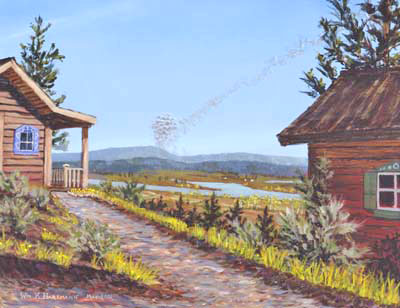
Smoke on the
horizon
Painting © William K. Hartmann
Some minutes after the explosion,
distant observers reported a column of smoke on the horizon. The
general terms indicated this was a vertical column.
One observer
said,
"Where the body disappeared
behind the horizon, a pillar of dark smoke rose up."
It seems unclear from the reports
whether this was:
(a) an mushroom-like
cloud from the explosion fireball rising above the landscape
and pulling up smoke from the ignited forest
(b) smoke from the forest
fire
(c) from some directions,
a reference to the contrail, which would be vertical when
seen under the flight path
I have wondered whether the dark
color could result from the smoke of the explosion containing
black, sooty carbonaceous particles, in the same way that the
explosion clouds on Jupiter from the impact of
Comet
Shoemaker-Levy 9 were very dark.
This view represents the scene
from a village along the Angara River, about 170 km SW of the
blast.
The original was painted from among cabins in a state
park in Oregon.
What was the
explosion?
Because the meteorite did not strike the
ground or make a crater, early researchers thought the object might
be a weak, icy fragment of a comet, which vaporized explosively in
the air, and left no residue on the ground.
However, modern
planetary scientists have much better tools for understanding
meteorite explosion in the atmosphere. As a meteorite slams into the
atmosphere at speeds around 12 to 20 km/sec or more, it experiences
a strong mechanical shock, like a diver bellyflopping into water.
This can break apart stones of a certain
size range, which explode instead of hitting the ground. Some of
them drop brick-sized fragments on the ground, but others, such as
the one that hit Siberia, may produce primarily a fireball and cloud
of fine dust and tiny fragments.
In 1993 researchers Chris Chyba,
Paul Thomas, and Kevin Zahnle studied the Siberian explosion and
concluded it was of this type -- a stone meteorite that exploded in
the atmosphere.
This conclusion was supported when
Russian researchers found tiny stoney particles embedded in the
trees at the collision site, matching the composition of common
stone meteorites.
The original asteroid fragment may have been
roughly 50-60 meters (50-60 yards) in diameter.
If asteroids
hit Earth, why don't we see more such explosions?
Many asteroidal fragments circle the Sun; the Siberian object was
merely the largest to hit the Earth in the last century or so.
Had
it hit a populated area, devastation would have been enormous. If
there are many asteroid fragments, why don't we see more hits? We
do! The problem is that they have not been understood until
recently. Current studies reveal that such explosions may happen
every couple of centuries; however, six out of seven happen over the
ocean, and few happen over populated land.
A key to the phenomenon
is: the larger the impact the rarer it is.
An Air Force satellite in the 1990s
detected a smaller explosion over the Pacific. In 1972, a 1000-ton
object skimmed tangentially through Earth's atmosphere over the
Grand Tetons in Wyoming, and then skipped back out into space, like
a stone skipping off water. It was photographed by tourists and
detected by Air Force satellites.
Had it continued on into the
atmosphere, it could have caused a Hiroshima-scale explosion over
Canada, somewhat smaller than the Siberian blast. Even larger
objects have hit Earth, but they are more rare.
For example, an iron asteroid fragment
perhaps 100 m across hit Arizona about 20,000 years ago, leaving the
kilometer-wide "Arizona Meteor Crater," which is open to visitors;
and a 10-km asteroid hit Earth 65 million years ago, ending the
reign of dinosaurs. Brick-sized interplanetary stones fall from the
sky in various locations every year.
Several houses and a car have
been hit in recent decades.
Tiny dust grains are even more common;
they can be seen every night if you watch long enough; they are the
bright streaks of light sometimes called "shooting stars."
Interplanetary space contains many small bodies of different sizes.
All of them move in elliptical orbits around the sun as prescribed
by Kepler.
Occasionally their orbits intersect
those of planets, leading to a collision. Large enough bodies leave
sizable craters on planets or satellites. This explains why impact
craters are present on surfaces of planets and moons throughout the
solar system.
If we continue to study asteroids and build more
telescopes for detecting and tracking them, we will have better
information about the frequency of such asteroid impact-explosions,
and more chance to have warning about impending impacts.
Question
Tunguska-sized explosions occur on Earth about once per century, and
larger explosions the size of the largest H-bombs, occur about once
per millennium.
Many of these explode in the atmosphere and cause
devastation over tens of kilometers, but don't leave long-lasting
craters. Recall that 1/6 of Earth is covered by land and assume that
roughly half the land surface is populated in the last 12,000 years,
since humans moved into the Americas.
Using these facts comment on whether
meteorite explosions of this scale might plausibly have produced
legends of wrathful or capricious celestial gods who could rain fire
onto the Earth, as for example in the legend of the
destruction of
Sodom and Gomorrah by celestial fire.
Take into account that oral
traditions, such as the associations of certain star patterns with
constellations such as the Great Bear (Ursa Major), can apparently
be passed down for thousands of years.
Answer:
Let's make use of what scientists call an "order of magnitude"
estimate, or "back of the envelope calculation."
If we imagine
spectacular catastrophic explosions larger than Tunguska happening
every 300 years, and having effects visible over 100 km or more from
ground zero, then there would be one over land about every 1800
years, and perhaps one over a populated area every 3600 years or so.
Thus it seems plausible that in 12,000 years of oral tradition and
about 4000 years of written records in some cultures, there may have
been one ore more explosions considerably larger than . By the same logic, if Tunguska-scale events happen once per
century, there could have been several just in the last several
scattered around the populated land areas of the world in the last
3600 years.
Thus, it seems at least plausible that large explosions of
meteoritic objects were among the celestial events (together with
smaller meteorite impacts, auroras, hurricanes, storms, and floods)
that gave rise to belief in capricious god-like forces acting from
the skies.
Problem
Recent scientific studies by meteorite researcher Christopher
Chyba have estimated that the Tunguska event may have been
caused by the explosion of a stony meteoroid about 30 meters in
diameter traveling at about 15 km/s.
Compare the energy released by
such an object with that of an atomic bomb such as those dropped on
Japan in World War II.
Answer:
Here again we can make a simple "order of magnitude" calculation.
First, we have to know the energy liberated by an A-bomb. The
Hiroshima bomb expended the energy of roughly ten thousand tons of
TNT, or 18 "kilotons" in military parlance. One kiloton (1 KT) is
about 4.2 x 1012 joules (the joule is the unit of energy
in the Standard International, or "SI," set of scientific units).
The Hiroshima bomb thus represented roughly 8 x 1013 joules of
energy.
Now all we have to do is calculate the energy of the meteoroid. In
freshman physics courses, you learn that the kinetic energy of a
moving object is 1/2mV2.
The trick in using any equation like this is to be sure to use the
correct units. In SI, the units are meters, kilograms, and seconds,
so that mass m must be in kilograms and velocity V must be in
meters/second.
Thus, right away we can say that V in the equation will be V = 15
km/s or 1.5 x 104 m/s.
To get the mass, we have to figure out the mass of a 30-meter wide
rock. Rock has a density of about 3000 kg per cubic meter, so we
need to calculate the volume of the rock and multiply times this
density.
Thus we have,
m = (4/3) PI R3 (3000
kg/m3) = (4/3) PI (15 m)3 (3000) = 4.2
x 107 kg.
Thus the total energy is,
E=1/2 (4.2 x 107 kg) (1.5 x 104 m/s)2
= 4.8 x 1015 joules.
To be safe, let's imagine that half the
kinetic energy is lost to noise, slowing, and fragmentation of the
meteoroid before it explodes. That still leaves about 2 x 1015
joules for the Tunguska explosion, compared to about 3 x 1013
joules for the Hiroshima A-bomb.
Thus, our estimate is that the Tunguska had an explosive energy
roughly on order of 60 A-bombs, or 500 KT of TNT. It was closer in
effect to a very large H-bomb.
For further
information
-
Chyba, C., P. Thomas, and K. Zahnle
1993. "The
1908 Tunguska Explosion - Atmospheric Disruption of A Stony
Asteroid". Nature 361, p. 40-44. (Calculation of size of
the bolide.)
-
Gallant, Roy A. 1994 "Journey to
Tunguska". Sky and Telescope, June, 38-43. (Description of a
modern journey to the site, with photographs.)
-
Krinov, E. L. 1966 Giant Meteorites
(London: Pergamon Press). Description of the site and
interviews with witnesses.
|

 vibrations
were recorded by sensitive instruments as much as 1000 km (600 mi)
away.
vibrations
were recorded by sensitive instruments as much as 1000 km (600 mi)
away. 


